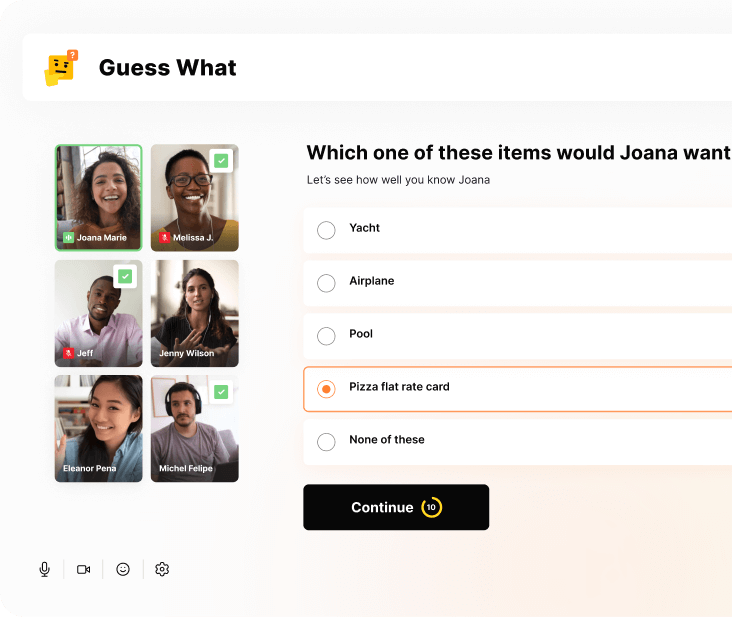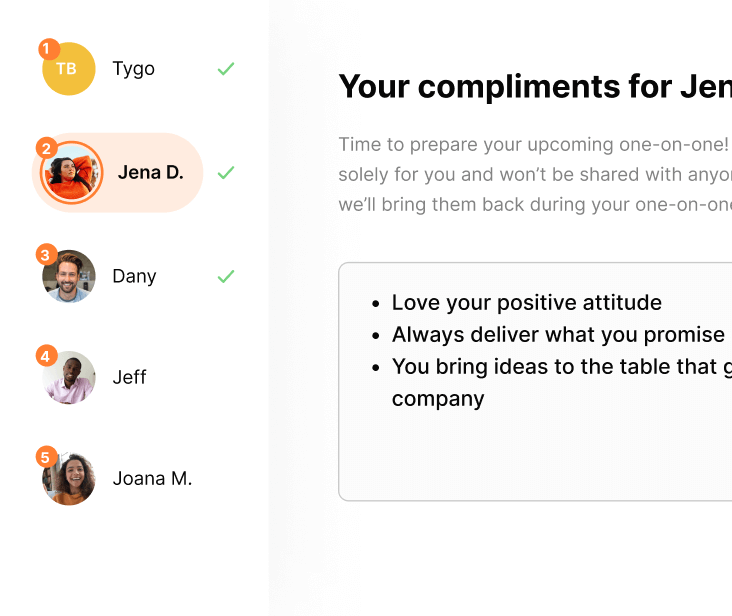Back to Blog
3 levels of employee engagement (and how to reach the top)
How engaged are your employees?
Today's competitive marketplace demands employee engagement to succeed. Yet, recent research shows only 20% of employees worldwide are engaged at work. This means 80% of workers aren't able to live up to their full potential, and organizations are losing out. Employee engagement statistics show highly engaged companies are 21% more profitable.
If you don’t know your team’s levels of employee engagement, you should. The key to success in your team is understanding and improving employee engagement.
Share fun facts and bond with a team quiz
Have your participants choose from a list of questions they’d like their coworkers to answer about them, before watching as they guess the right answer.
01. Yes
share-fun-facts-and-bond-with-a-team-quiz

Run a guided recognition activity
Have your participants choose from a list of questions they’d like their coworkers to answer about them, before watching as they guess the right answer.
01. Yes
run-a-guided-recognition-activity

Organize a virtual cooking class
Hire a professional chef to help your team cook a delicious lunch or dinner. May be difficult for co-workers with families. To find providers and get tips, read our blog about virtual cooking classes.
02. No
organize-a-virtual-cooking-class

Hire a stand-up comedian
Have your participants choose from a list of questions they’d like their coworkers to answer about them, before watching as they guess the right answer.
02. No
hire-a-stand-up-comedian

No items found
No items found
Table of contents
How engaged are your employees?
Today's competitive marketplace demands employee engagement to succeed. Yet, recent research shows only 20% of employees worldwide are engaged at work. This means 80% of workers aren't able to live up to their full potential, and organizations are losing out. Employee engagement statistics show highly engaged companies are 21% more profitable.
If you don’t know your team’s levels of employee engagement, you should. The key to success in your team is understanding and improving employee engagement.
The 3 levels of employee engagement
An employee's engagement level is the degree to which they’re committed to and involved in their organization.
Various factors can affect employee engagement levels, but most employees fall into one of three categories: engaged, not engaged, or disengaged.
An employee's level can be determined by a variety of metrics, including employment turnover rate, Employee Net Promoter Score (eNPS), and absenteeism. Most companies use apps or other software solutions to measure engagement.
1. Actively engaged
Engaged employees are passionate about their work and committed to their goals. They bring a positive attitude and creativity to problems. These employees go above and beyond expectations, taking ownership of projects and striving to represent the company's culture.
Example: Absenteeism is measured by dividing absences by days in a period and multiplying by 100. Low absenteeism rates signal employee engagement — general rule of thumb is 1.5%.
2. Not engaged
Employees who aren't engaged have low interest and involvement in their jobs. They don't contribute beyond adequate performance or put much effort into their work. These employees follow orders but are indifferent about their tasks. They don't show enthusiasm for team building activities or connection.
Example: In 2021, full-time wage and salary workers in the US had an annual absence rate of 3.2%. Rates higher than this (without an obvious cause, such as illness) may signal a lack of engagement.
3. Actively disengaged
Disengaged employees tend to be outliers in the workplace. These employees are unproductive, unhappy, and resentful. They often spread negativity within the organization and complain about their jobs. They don't take part in team building or contribute ideas at meetings.
Example: With more than 75% of Americans considering quitting their jobs, excessively high absence rates, such as 5% or higher, should be investigated further.
How to measure employee engagement levels
The only way to know your team’s current level of employee engagement is to measure it. There are several methods you can use to measure engagement. Among the top choices are:
- Pulse surveys
- In-person meetings
- Continual anonymous feedback
- Exit interviews
- Employee Net Promoter Score (eNPS) surveys
- Annual in-depth surveys
Each of these methods will produce metrics you can use to measure and improve employee engagement, and many companies use a combination of methods. There isn’t a right or wrong choice — the best employee engagement measurement method is the one you feel comfortable using regularly.
3 ways to increase (or maintain) levels of employee engagement
Did you know that 70% of the variance in team engagement is determined by its leaders?
Yet, only 26% of managers surveyed reported it as a "very important part of what they think about, plan, and do every day."
If employee engagement isn't your top priority, it should be. There are many employee engagement strategies you can try, but ultimately, you can improve levels of employee engagement by focusing on company culture. Remote employees should feel connected, valued, and appreciated.
Here’s how.
1. Promote a culture of connection
An employee engagement strategy that builds teamwork and strengthens employee relationships is vital. Research shows when leaders prioritize connectedness, they experience:
- 34% higher goal achievement
- a 35% rise in wellbeing
- 92% greater career growth
How to do it: Make team building a part of your company culture with an employee engagement platform. With Gomada, your team can participate in pre-made online activities like Guess What? to get to know each other — no awkward mixers or trust falls required.
2. Engage in regular feedback
Open and honest communication is a vital aspect of any relationship. Employee engagement relies on regular feedback, both positive and constructive. Daily feedback increases engagement three times more than annual feedback, according to research.
How to do it: Plan weekly check-ins with your team. Share what they're doing well and what they can improve, and let them know you'd like their feedback. Employees feel valued and respected when there's open, regular communication. Feedback software can help you simplify the process and drive more meaningful conversations.
3. Recognize employees
Encourage a culture of appreciation by recognizing your team members for their successes. Research shows recognition increases motivation by up to 2.7 times. Peer recognition is especially strong.
How to do it: Host an Appreciation Shower with Gomada. In this activity, make your colleagues feel appreciated by praising them. You'll automatically rotate through 1:1s, exchanging what makes each other unique and why you like working with them. Afterwards, your team will feel motivated, valued, and satisfied.
Subscribe to get our latest updates
Subscribe to get our latest updates
.webp)



.jpg)

